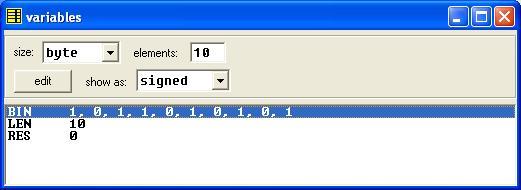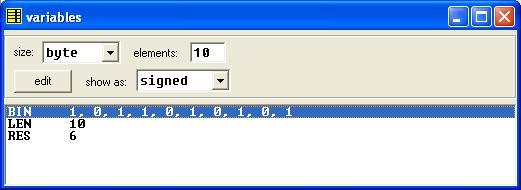Now we will write another Assembly program for finding the largest number in array of 10 elements.
First variables will be the one which will hold the value discovered as the Sum of All the Binary Digits in Array list and it will be RES and Second will be the one which will hold the values present in the Given Binary Digits in Array list and it will be array BIN. Other variables will be holding Length of the Array and it will be LEN, So in all Three variables.
The identified variables are BIN, LEN and RES.
First Line – DATA SEGMENT
DATA SEGMENT is the starting point of the Data Segment in a Program and DATA is the name given to this segment and SEGMENT is the keyword for defining Segments, Where we can declare our variables.
Next Line – BIN DB 1,0,1,1,0,1,0,1,0,1
LEN DW $-BIN
RES DB ?
BIN DB 1,0,1,1,0,1,0,1,0,1 this line is a declaration of Binary Digits in Array initialized with 1,0,1,1,0,1,0,1,0,1 the numbers are seperated by Comma (,). LEN DW $-BIN is used to Save the Length of the Array which will be generated by $-Name of the array i.e. $-BIN. RES DB ? We are initializing RES to ? (? stands for blank value). Detailed explanation is given below.
Next Line – DATA ENDS
DATA ENDS is the End point of the Data Segment in a Program. We can write just ENDS But to differentiate the end of which segment it is of which we have to write the same name given to the Data Segment.
Now, Selection of data type is DB data type the numbers which we are adding will be integers so DB is sufficient.
[codesyntax lang=”asm”]
DATA SEGMENT
BIN DB 1,0,1,1,0,1,0,1,0,1
LEN DW $-BIN
RES DB ?
ENDS
[/codesyntax]
In Assembly programming, the variable are all defined by bytes only.
DB – Define Byte (Size – 1 Byte)
DW – Define Word (Size – 2 Byte)
DD – Define Double word (Size – 4 Bytes)
DQ – Define Quad word (Size – 8 Bytes)
DT – Define Ten Bytes (Size – 10 Bytes)
NUMBER SYSTEM in Assembly Programming is Decimal, Octal, Hexadecimal, Binary.
In the Program, We are entering the values for the variables and Do arithmetical Operations like Addition, Subtraction, Multiplication and Division So the Computer should understand which kind of Number is entered. Hence there is a different letters for different Number Systems. O or o stands for Octal, H or h stands for Hexadecimal, B or b stands for Binary, D or d stands for Decimal. By default type of numbering system is Decimal. If you do not specify any letter then the number is understood to be Decimal (By default).
[codesyntax lang=”asm”]
DATA SEGMENT
BIN DB 1,0,1,1,0,1,0,1,0,1
LEN DW $-BIN
RES DB ?
ENDS
CODE SEGMENT
ASSUME DS:DATA CS:CODE
START:
MOV AX,DATA
MOV DS,AX
LEA SI,BIN
MOV CX,LEN
MOV AL,0
NEXT:
CMP [SI],1
JNE SKIP
INC AL
SKIP:
INC SI
LOOP NEXT
MOV RES,AL
MOV AH,4CH
INT 21H
ENDS
END START
[/codesyntax]
Explanation :
In this Assembly Language Programming, A single program is divided into four Segments which are 1. Data Segment, 2. Code Segment, 3. Stack Segment, and 4. Extra Segment. Now, from these one is compulsory i.e. Code Segment if at all you don’t need variable(s) for your program.if you need variable(s) for your program you will need two Segments i.e. Code Segment and Data Segment.
Next Line –CODE SEGMENT
CODE SEGMENT is the starting point of the Code Segment in a Program and CODE is the name given to this segment and SEGMENT is the keyword for defining Segments, Where we can write the coding of the program.
Next Line – ASSUME DS:DATA CS:CODE
In this Assembly Language Programming, their are Different Registers present for Different Purpose So we have to assume DATA is the name given to Data Segment register and CODE is the name given to Code Segment register (SS,ES are used in the same way as CS,DS )
Next Line – START:
START is the label used to show the starting point of the code which is written in the Code Segment. : is used to define a label as in C programming.
Next Line – MOV AX,DATA
MOV DS,AX
After Assuming DATA and CODE Segment, Still it is compulsory to initialize Data Segment to DS register. MOV is a keyword to move the second element into the first element. But we cannot move DATA Directly to DS due to MOV commands restriction, Hence we move DATA to AX and then from AX to DS. AX is the first and most important register in the ALU unit. This part is also called INITIALIZATION OF DATA SEGMENT and It is important so that the Data elements or variables in the DATA Segment are made accessable. Other Segments are not needed to be initialized, Only assuming is enhalf.
Next Line – LEA SI,BIN
LEA SI,BIN in this LEA stands for LOAD EFFECTIVE ADDRESS and it loads the effective address of second element into the first element. This same code can be interchangably written as MOV DX, OFFSET PRICE where OFFSET means effective address and MOV means move second element into the first element. Here Base Address of variable PRICE is loaded in DX register.
Next Line – MOV CX,LEN
MOV CX,LEN is used to move or assign value 8 (Length of Array) to CX. In assembly programming language we have a LOOP instruction. This works with two other helpers which are Label and Counter. The Loop start with LABEL and ends with LOOP instruction with the same LABEL name with it. the execution of the Loop depends on the value in CX register ( CX is also Called COUNTER).
Next Line – MOV AH,0
MOV AH,0 here, AL register will be incremented if we find ONE (1) in Array later. Hence the unwanted value (garbage value) in AH register is removed by assigning ZERO to it.
Next Line – NEXT:
NEXT: is a LABEL and all the words ending in colon (:).
Next Line – CMP [SI],1
JNE SKIP
CMP [SI],1 is used to compare Effective Address of SI register (Element in Array) with 1 and JNE SKIP jump if Effective Address of SI register (Element in Array) is Not Equal to the respective LABEL SKIP, When compared with value 1. The result of Comparision is not stored anywhere, but flags are set according to result. is Short Jump if first operand is Not Equal to second operand (as set by CMP instruction). Signed. SKIP is the label where the compiler will JUMP.
Next Line – INC AL
INC AL will increment the AL register by 1.
Next Line – SKIP:
SKIP: is a LABEL and all the words ending in colon (:).
Next Line – INC SI
INC SI will increment the Address value present in SI register. Here we are using SI register as a SOURCE INDEX which holds the Address of Array elements to Cover all the elements in Array.
Next Line – LOOP NEXT
LOOP NEXT This end of loop. In assembly programming language we have a LOOP instruction. This works with two other helpers which are Label and Counter. The Loop start with LABEL and ends with LOOP instruction with the same LABEL name with it. the execution of the Loop depends on the value in CX register ( CX is also Called COUNTER).
Next Line – MOV RES,AL
MOV RES,AL is to move AL register (Sum of Binary Digits in Array) to RES variable which holds Resultant value.
Next Line – EXIT: MOV AH,4CH
INT 21H
The above two line code is used to exit to dos or exit to operating system. Standard Input and Standard Output related Interupts are found in INT 21H which is also called as DOS interrupt. It works with the value of AH register, If the Value is 4ch, That means Return to Operating System or DOS which is the End of the program.
Next Line – CODE ENDS
CODE ENDS is the End point of the Code Segment in a Program. We can write just ENDS But to differentiate the end of which segment it is of which we have to write the same name given to the Code Segment.
Last Line – END START
END START is the end of the label used to show the ending point of the code which is written in the Code Segment.
Note :- In this Assembly Language Programming, We have Com format and EXE format. We are Learning in EXE format only which simple then COM format to understand and Write. We can write the program in lower or upper case, But i prepare Upper Case.
Screen Shots :-
Output Before Execution :-
Output After Execution :-
Note :- To see the variable and its value you have to click vars button in the emulator.
Note:- To understand program for sequence in detail Please SEARCH numerically example: ASSEMBLY01, ASSEMBLY02, etc.



